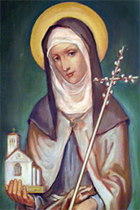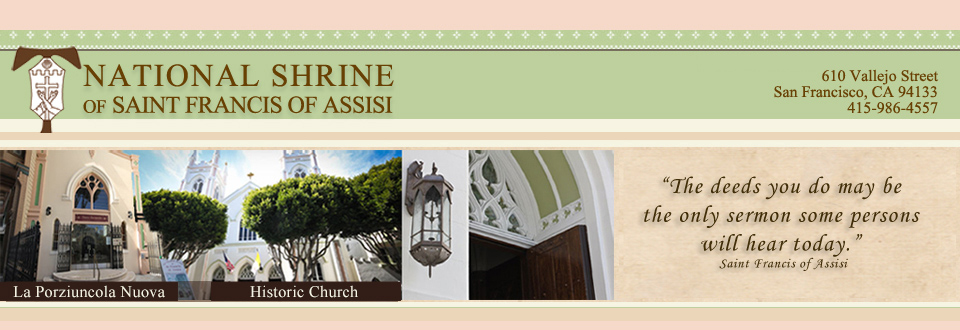
Clare of Assisi
Saint Clare of Assisi (also Claire of Assisi), born Chiara Offreduccio, (July 16, 1194 – August 11, 1253) was one of the first followers of Francis of Assisi and founded the Order of Poor Ladies[1] to organize the women who chose to embrace monastic life in the Franciscan vision. Clare led the order for nearly 40 years through a life of service and absolute poverty, yet with a joyous spirit of mystical union with Christ. Many miracles were attributed to her, and Francis himself turned to her for guidance when he doubted his ministry. Suffering ill health due to extreme fasting, she was often confined to her bed. She was the first woman to write her own Rule for a monastic house, determinedly avoiding the domination of many bishops and several popes who attempted to change her steadfast devotion to poverty. Through the missionaries and letter writing, she is credited with inspiring the establishment of 22 monastic houses and was affiliated with 110 convents altogether.
In an age where women were often used as political tools in marriage and found little joy or self-expression, Clare established a life of religious joy and devotion for women that allowed them to express their love in purity and humility.
Early Life
Clare was born in Assisi, Italy, in 1194 as the eldest daughter of Favorino Scifi, Count of Sasso-Rosso, and his wife Ortolana. Her mother was a very devout woman who had undertaken pilgrimages to Rome, Santiago de Compostela and the Holy Land. Later in life, after her husband had died at a relatively young age, Ortolana left home and entered a monastery associated with the Sisters of the Poor, joining her three daughters in the monastic calling. Clare's aunt Bianca also joined the monastic call.
In 1210, Clare heard the future Saint Francis preaching in the streets of Assisi about his new mendicant order, then newly-approved by Pope Innocent III, and was deeply moved by his words. On March 20, 1212, Clare left her home to follow Francis, who received her into religious life.
Clare chose Palm Sunday, the day Jesus entered Jerusalem, as the day she would leave the worldly life. In Assisi, Palm Sunday was usually the scene of the coming-out parties of the town's wealthy girls, who, dressed in their finery, would receive a palm frond from the local bishop. Clare did not follow the tradition on this day; instead she sat with her family "as if in a trance" when the bishop walked by. That night she secretly left her home through the back door. Accompanied by a friend, she walked out of town to the small Saint Mary's Church in Portiuncula, where Francis waited for her.
With the brothers looking on, Francis cut Clare's hair short. She put on a rough tunic and a veil to indicate her acceptance of the vows of poverty, chastity and obedience. Cutting her hair was also a sign to her family that she would not go back home.
It seemed that Francis had no plan as to where Clare should stay, so she lodged first with a nearby monastery of Benedictine nuns at San Paolo delle Abadesse and then into the community of Sant'Angelo in Panza on Mont Subasio. Her sister Agnes left her parents and relatives 16 days later and followed Clare to Sant'Angelo. In both cases, their angry family was unable to take the daughters back home.
After Francis and the brothers finished restoring the little Damiano church outside Assisi, Clare and Agnes moved to San Damiano, where they founded the Order of Poor Ladies and many women of the region quickly joined them. Francis called out to a person passing by during the restoration, "Come and help me build the monastery of San Damiano, because ladies will again dwell here who will glorify our heavenly Father … by their celebrated and holy manner of life." [2] Clare would remain there for the rest of her life. Agnes would leave only to help establish a convent near Florence, returning before Clare's death. Their younger sister, Beatrice, joined them in 1229.
Monastic Life
Unlike the Franciscan order, whose members moved around the country to preach, Clare's nuns lived in enclosure, since an itinerant life was hardly conceivable at the time for women. Their life consisted of manual labor and prayer. [3] They wore no shoes, ate no meat, lived in poor housing and remained silent for most of the time.
As the first Franciscan nun, at age 18, Clare was the natural leader of her convent. However, only after Francis' prayerful insistence for three years would she accept the position of "Mother" of the group, at 21 years of age. She led not by a formula or strict rules but by her own life example often going at night to make sure her sisters were covered by their meager blankets.
To feed and care for a house of women who denied earthly needs was a great challenge. Clare put her trust in God. She endeavored to make herself a living vessel of God's grace. Her method to achieve this was to empty herself of all desires, even the desire for food, sleep and warmth. Clare seriously jeopardized her health through excessive fasting in the early years of her monastic life. Francis had to step in and convince her that the true spirit of Christian mortification of the flesh did not mean literally to sacrifice one's body to the point of death, but only to "die" to the world of desire. He insisted that she eat at least a little food every day afterwards. Yet, for decades, she could hardly walk due to her weakness from fasting.
Clare believed that everyone who followed the life of monastic devotion to Christ was called by God, so she did not urge others to follow her ascetic practice. She saw her choice as a joyous embracing of living with and for Christ, like a lover who feels neither cold nor hunger. Clare saw herself as such a lover, running full tilt toward her Beloved, "with swift pace, light step, unswerving feet, so that even your steps stir up no dust."[4]
In a letter to Agnes of Prague, who, with Clare's support, founded her own Franciscan monastery, she expressed her understanding of contemplative prayer:
Place your mind before the mirror of eternity!
Place your soul in the brilliance of glory!
Place your heart in the figure of the divine substance!
And transform your entire being into the image of the Godhead Itself through contemplation.—Early Documents 44[5]
She taught that in the depth of prayer one should look closely at the image of Christ, for in it one finds her own true self. By drawing intimately close to Christ as God incarnate, one discovers her own unity with God, realizing that it was there all along. At times Clare was so deep in prayer that she reached a state of unconsciousness.
Through Clare's personal sacrifice she found many ways to give to others. She was seen as a healer, of body, mind and soul. She reportedly even protected her convent from invading troops, as well as saving the city of Assisi from an attacking army. Miracles of feeding the hungry were attributed to her as well.
Clare found sacred poverty a source of great power in her work at the monastery. During the 30 years of her monastic life she was unswerving in her dedication to the life sine proprio—without property. Over and over again, the Church leadership tried to give her an endowment, but she refused, believing God would somehow provide for her and her sisters. The new Franciscan spirituality involved a passion for faith, evangelism to the poor and needy, and a total rejection of the rich life of the typical Benedictine houses. This created a tension between the old order and the new.
Francis and Clare worked in concert for only eight years, until Francis death in 1226. After this, Clare continued, in the next 27 years, to promote the growth of her order, writing letters to abbesses in other parts of Europe and thwarting the attempts by each successive Pope to impose a Rule on her order that would water down the radical commitment to corporate poverty that she and Francis had originally embraced. She maintained this principle despite the fact that she had endured a long period of poor health until her death.
Clare as spiritual lover
Clare's spirituality owed much to at least one man other than her mentor, Saint Francis. The earlier reforming monastic leader, Bernard of Clairvaux had given a series of sermons in the mid-twelfth century on the Song of Songs. In these works he moved away from the typical medieval religious thought of feudal society where the religious were thought of as warriors for God. Bernard used a powerful mystical metaphor for the monastic life, in which both men and women were seen as the Bride of Christ. He urged his monastic readers to "anoint and bejewel" themselves inwardly and ready themselves in every way for the "kiss of Christ"—for the experience of mystical union with God.
This gentler role of a monastic gave women validation of their own femininity, rather than denigrating them as fallen Eve—the temptress, luring men into hell. From this new mystical teaching women could rise above the cultural burden of the male-dominated society and find a safe and uplifting expression of love, allowing them to become lovers of Christ, fully as women. Women felt liberated and fulfilled in the monastic life.[6]
The relationship between Clare and Francis, meanwhile, represented the highest form of courtly love at the time, not in a romantic sense as the term is understood today, but as a union of spiritual devotion to a higher purpose. A major tension existed between the spiritual and physical during the Middle Ages, especially in the relationship between men and women. Francis and Clare's pure relationship represented the ultimate love that a man and woman could have by the standards of the day—that of brother and sister in Christ—each being in love with Christ, each being a lover of Christ and of humankind through their sacrificial devotion and service. Clare, nobly born, beautiful and courageous, followed her spiritual lover, not into marriage but into a mystical union with Christ. Their example was famous, and Clare exuded great joy and happiness in her choice, which was so attractive to others that they also left their worldly possessions and joined the Sisters of the Poor.
Clare's words
From a letter to Agnes of Prague:
Go forth in peace, for you have followed the good road. Go forth without fear, for he who created you has made you holy, has always protected you, and loves you as a mother. Blessed be you, my God, for having created me.
He Christ is the splendor of eternal glory, "the brightness of eternal light, and the mirror without cloud." Behold, I say, the birth of this mirror. Behold Christ's poverty even as he was laid in the manger and wrapped in swaddling clothes. What wondrous humility, what marvelous poverty!
The King of angels, the Lord of heaven and earth resting in a manger! Look more deeply into the mirror and meditate on his humility, or simply on his poverty. Behold the many labors and sufferings he endured to redeem the human race. Then, in the depths of this very mirror, ponder his unspeakable love which caused him to suffer on the wood of the cross and to endure the most shameful kind of death. The mirror himself, from his position on the cross, warned passers-by to weigh carefully this act, as he said: "All of you who pass by this way, behold and see if there is any sorrow like mine." Let us answer his cries and lamentations with one voice and one spirit: "I will be mindful and remember, and my soul will be consumed within me.[7]
Another letter encouraging Agnes:
Place your mind before the mirror of eternity! So that you too may feel what His (Jesus') friends feel as they taste the hidden sweetness which God has reserved from the beginning for those who love Him.[8]
Legacy
Clare established 22 other houses of Poor Ladies in her life including the one in Prague, established by Agnes, a princess of the house of the king of Bohemia. They had never met, but after two failed political marriages by age 20, Agnes was looking for a more meaningful life. Hearing about Clare through sermons given by the brothers, she wrote to Clare and through their correspondence Agnes determined to establish a convent for the Sisters of the Poor with help from five of Clare's sisters from Assisi, and seven local wealthy women. Clare's letter writing and supervision of missionary work would inspire the foundation of numerous other establishments as well.
Clare was the first woman to write a Rule for a monastery. She rejected the Benedictine-based Rule written for her order, by Cardinal Hugolino, which denied them absolute poverty as well as the link between Clare's sisters and the brethren that Francis had promised just before his death. Pope Innocent IV offered an alternative Rule that he himself wrote in 1247, removing any mention of St. Benedict. This too, however, was rejected by Clare.
At 55 years of age, Clare began to write her own Rule just three years before she died. Her words included no specific warning to new sisters concerning suffering or sacrifice, but simply said: "Let the tenor of our life" be explained to new members. She did not use the French word for "nun" but only "sister." She stated, "If, by divine inspiration, anyone should come to us desiring to accept this life, the Abbess is required to seek the consent of all the sisters."
Her rule indicates that good sense would guide everyone in the convent. Concerning what the sisters should wear, Clare instructed them to wear something poor, as Jesus was wrapped in swaddling clothes and laid in a manger. The role of the abbess should not be to monitor the behavior of the nuns but as a "servant of all the sisters." Clare's attitude was constantly one of joy, gratitude, and deep respect for those who shared her style of life. "For if a mother loves and nourishes her child according to the flesh, should not a sister love and nourish her sister according to the Spirit even more lovingly?" [9]
It is a testimony to the moral, spiritual, and indeed even the political power of the Franciscan movement of the mid-thirteenth century that Clare was able to prevail against high ecclesiastical authorities in her determination to guide her order on the basis of a strict poverty that flew in the face of many of the era's monastic establishments. On August 9, 1253, the Papal bull Solet annure confirmed that Clare's Rule would serve as the governing rule for the Order of Poor Ladies. Two days later, on August 11, Clare died at the age of 59. Pope Innocent IV wrote these words of Clare:
O wondrous blessed clarity of Clare! In life she shone to a few;
After death she shines on the whole world! On earth she was a clear light;
Now in heaven she is a brilliant sun.
O how great the vehemence of the brilliance of this clarity!
On earth this light was indeed kept within cloistered walls,
Yet shed abroad its shining rays; It was confined within a convent cell,
Yet spread itself through the wide world. [10]
On August 15, 1255, Pope Alexander IV canonized Clare as St. Clare of Assisi. In 1263, Pope Urban IV officially changed the name of the Order of Poor Ladies to the Order of Saint Clare.
In the modern era, on February 17, 1958, Pope Pius XII designated her as the patron saint of television, on the basis that when she was too ill to attend a Mass, she had reportedly been able to see and hear it miraculously, on the wall of her room. The Eternal Word Television Network (EWTN) was founded by Mother Angelica, a Poor Clare.
In art, Clare is shown carrying a vessel, usually of gold or silver, in which the consecrated Host is exposed for adoration, in commemoration of the time when she warded away attackers at the gates of her convent by raising the Host over the wall.
Lake Saint Clair and the Saint Clair River in the Great Lakes region of North America were named on her feast day on August 12, 1679. However, since 1970, her feast day has been celebrated on the date of her death on August 11 in the revised liturgical calendar. Her skeletal remains were found to be in a perfect state of preservation and are displayed as a holy relic in Assisi.
Clare of Assisi. (2013, May 23). New World Encyclopedia, . Retrieved 20:43, August 5, 2016. http://www.newworldencyclopedia.org/p/index.php?title=Clare_of_Assisi&oldid=969446.



